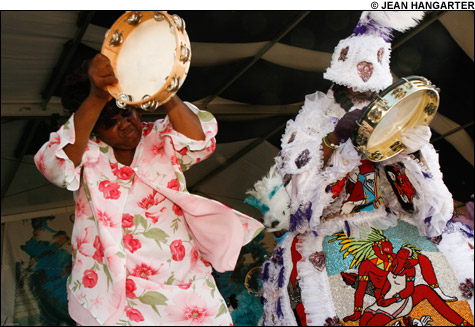©JeanHanga.jpg)
SISSY BOUNCE: Freedia & Nobby aren't afraid to take New Orleans's macho hip-hop gay. |
WFNX Jazz Brunch Top 5
1. Melody Gardot, You’re My Thrill [Verve]
2. Brian Blade, Mama Rosa [Verve Forecast]
3. Various Artists, Playing for Change: Songs Around the World [Hear Music]
4. Allen Toussaint, The Bright Mississippi [Nonesuch]
5. John Scofield, Piety Street [EmArcy] On the stomp. By Jon Garelick. |
"Sew all day, sew all night/Gonna sew that suit till I make it right." Big Chief KeKe was chanting, trading call-and-response with his crew, the Comanche Hunters Mardi Gras Indians, and with the audience ("sew, sew, sew") — the stage alight with colored feathers and beads. It was a scene you could have watched played out any number of times at the 40th annual New Orleans Jazz & Heritage Festival. The same chants — "Indian Red," "Shallow Water," "Shoo Fly," "Tu Way Packa Away." And the backing of nothing but parade drums and congas, the familiar call-and-responses, the freestyle verses of defiance and mayhem.Whatever increments of recovery New Orleans has made since Hurricane Katrina, in many ways the city never changes. The front page of the Times-Picayune on April 25, the first Saturday of the two-weekend Jazz Fest, was typical: big center-page piece on the fest, bracketed by a right-hand column on the FBI arrest of a state district judge and the left-hand column about the mayor's being investigated for corruption. The only shocker was a lower-left-hand piece, "Crime is down sharply in N.O." All the same, when we called a friend who had lived in the city for decades and told him which hotel we were staying at, his response was unequivocal: don't walk in that neighborhood after dark, take a cab. "The violence is indiscriminate and almost always involves guns." Sure enough, the Monday Times-Picayune reported 13 robberies over the weekend, most with guns, a couple not far from us.
But if corruption and violence are constants, so are the music and the city's beauty. Less often this year than last did I hear the cry of "We're back!" Or progress reports from the stage by musicians who were living out of state, had moved back, or were planning to move back soon. Instead, local musicians delivered the music without much editorial comment. And the locals are what draw my wife and me back year after year: Irma "Soul Queen of New Orleans" Thomas, Cajun music avatars Marc & Ann Savoy, pop-song polymath Allen Toussaint, brass bands like Rebirth, Dirty Dozen, and Mahogany, Mardi Gras Indians like the Comanche Hunters, the Golden Star Hunters, the Semolian Warriors, Creole Wild West, the Golden Eagles. And yeah, every once in a while, we'd slip over to the football-field-sized Acura Stage to hear a few minutes of Joe Cocker or Pete Seeger. (We skipped the big first-weekend draw, Dave Matthews — though Wilco sounded nice as we headed for the shuttle buses back to the French Quarter at the end of the day.)
Here is indigenous music, slow-cooked over generations in the neighborhoods that Katrina all but wiped out. Last year, Big Chief Darryl Montana of the Yellow Pocahontas told us about the making of his Indian suits, a craft he learned from his father, the late, great "Chief of Chiefs," Allison "Tootie" Montana. This year, we nabbed Fred Starr after a terrific performance by his Louisiana Repertory Jazz Ensemble. With their white shirts, black pants, and black ties — not to mention their name — the LRJE are half a world away from the Mardi Gras Indians, but no less vital. Their take on Jelly Roll Morton's "Black Bottom Stomp" began "thunk-whap!" and didn't let up, tight but with a timbre at once mellow and raw.

SUITING UP The Mardi Gras Indians enact multi-generational knowledge at Jazz Fest.
|
Breathless after the show, Starr explained the band's beginnings 30 years ago, when he hunted up 78s and sheet music and, most important, the musicians from the '20s and earlier who were still alive and willing to talk about arrangements, repertoire, and instrumentation, often defying today's conventional wisdom about the past. ("Everybody had saxophones, but now it's considered anathema!") Among New Orleans's heterogeneous immigrant community, Starr maintained, it was the Sicilians, with their superb technique and legato melodies, who evoked awe and were vastly influential. And so the LRJE chose woodwind and brass instruments that were pretty much extinct, with their wide bores and exotic fingerings, the less loud versions of their built-for-amplification descendants. This was music for dancing, said Starr, not for walloping seated concertgoers with volume, and the different pieces were inspired by dancers and the dances they were named for — one-steps, hops, rags, drags, stomps, and struts. "The dancers make the music, not the other way around!"